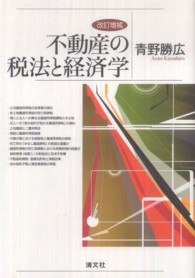- ホーム
- > 洋書
- > 英文書
- > Science / Mathematics
Full Description
Written by two leaders in the field with vast expertise in applied computational organic chemistry, this textbook provides those organic chemists unfamiliar with the topic with useful theoretical concepts and computational tools for predicting molecular structures and properties, as well as elucidating reaction mechanisms and analyzing spectra.
Throughout the book the authors discuss case studies in order to illustrate key points and to emphasize the capabilities of computational chemistry to solve problems and questions posed by the experimental work. They also include a unique appendix on good practices in reporting computational results as well as commonly used notations and formats.
Aimed at facilitating dialog between theoreticians and experimentalists, this is a valuable guide for graduates and researchers working in the field of organic chemistry, computational chemistry, physical chemistry, and medicinal chemistry as well as materials science.
Contents
1. THEORETICAL BASES FOR THE CALCULATION OF MOLECULAR PROPERTIES
1.1. The Time-independent Schrodinger Equation
1.2. Organic and Organometallic Molecules as Polyelectronic and Polynuclear Systems
1.3. Substituents and Functional Groups
1.4. Classical, Quantal and Hybrid Description of Organic Molecules
2. CALCULATING GEOMETRIES OF MOLECULES AND MACROMOLECULES
2.1. Cartesian and Internal Coordinates
2.2. Potential Energy Surfaces (Part I)
2.3. Time-dependent Phenomena
2.4. Excited States
2.5. Hybrid Methods for the Study of Complex Molecules
2.6. Computational Tools for the Study of Solvent Effects
3. CALCULATING SPECTROSCOPIC PROPERTIES OF ORGANIC AND ORGANOMETALLIC MOLECULES
3.1. Calculation of UV-visible Spectra
3.2. Calculation of IR Spectra
3.3. Calculation of NMR Spectra
3.4. Calculation of Chiroptic Properties
4. THEORETICAL ASSESSMENT OF THE REACTIVITY OF ORGANIC AND ORGANOMETALLIC MOLECULES
4.1. Connection between Traditional Reactivity Patterns and Theoretical Chemistry
4.2. Electron Density and Reactivity
4.3. Conceptual Density Functional Theory
4.4. Energy Partition-based Models
4.5. A Complementary View: Conceptual Valence Bond Theory
5. THEORETICAL ELUCIDATION OF REACTION MECHANISMS
5.1. Potential Energy Surfaces (Part II).
5.2. Computational Determination of Reaction Rates
5.3. Geometry Optimization
5.4. Concerted Mechanisms
5.5. Stepwise Mechanisms
5.6. Computational Tools for the Study of Photochemical Reactions
5.7. Two State Reactivity and Beyond
5.8. Theoretical Tools for the Study of Catalysis: Organic and Organometallic Catalysts
5.9. Theoretical Tools for the Study of Catalysis: Enzymes
6. THEORETICAL TOOLS FOR MATERIALS SCIENCE AND MEDICINAL CHEMISTRY
6.1. Predicting Electronic Properties of Organic Materials
6.2. Computational Prediction of Biological Responses
APPENDIX: GOOD PRACTICES IN COMPUTATIONAL CHEMISTRY





![論作文サブノート 〈[2006年度版]〉 - テーマ別答案添削満載 教員採用試験サブノートシリーズ](../images/goods/ar2/web/imgdata2/43196/4319684958.jpg)


